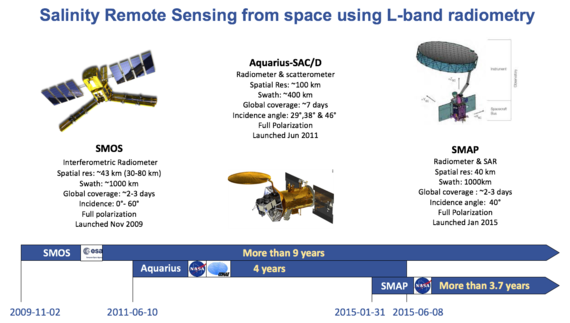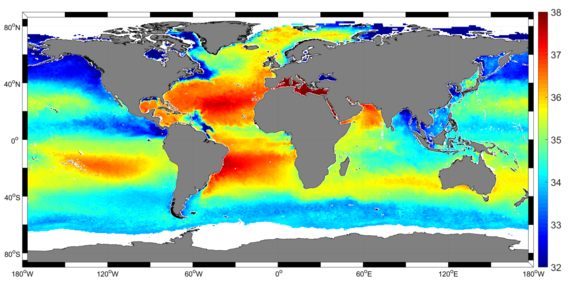Sea surface salinity estimates from spaceborne L-band radiometers: An overview of the first decade of observation (2010–2019)
Operated since the end of 2009, the European Space Agency (ESA) Soil Moisture and Ocean Salinity (SMOS) satellite mission is the first orbiting radiometer that collects regular and global observations from space of two Essential Climate Variables of the Global Climate Observing System: Sea Surface Salinity (SSS) and Soil Moisture. The National Aeronautics and Space Administration (NASA) Aquarius mission, with the primary objective to provide global SSS measurements from space operated from mid-2011 to mid-2015. NASA's Soil Moisture Active-Passive (SMAP) mission, primarily dedicated to soil moisture measurements, but also monitoring SSS, has been operating since early 2015.
The primary sensors onboard these three missions are passive microwave radiometers operating at 1.4 GHz (L-band). SSS is retrieved from radiometer measurements of the sea surface brightness temperature (TB). In a review paper published in Remote Sensing of Environment (https://doi.org/10.1016/j.rse.2020.111769), we first provide a historical review of SSS remote sensing with passive L-band radiometry beginning with the discussions of measurement principles, technology, sensing characteristics and complementarities of the three aforementioned missions. The assessment of satellite SSS products is then presented in terms of individual mission characteristics, common algorithms, and measurement uncertainties, including the validation versus in situ data, and, the consideration of sampling differences between satellite SSS and in situ salinity measurements. We next review the major scientific achievements of the combined first 10 years of satellite SSS data, including the insights enabled by these measurements regarding the linkages of SSS with the global water cycle, climate variability, and ocean biochemistry. We also highlight the new ability provided by satellites to monitor mesoscale and synoptic-scale SSS features and to advance our understanding of SSS' role in air-sea interactions, constraining ocean models, and improving seasonal predictions. An overview of satellite SSS observation highlights during this first decade and upcoming challenges are then presented.






